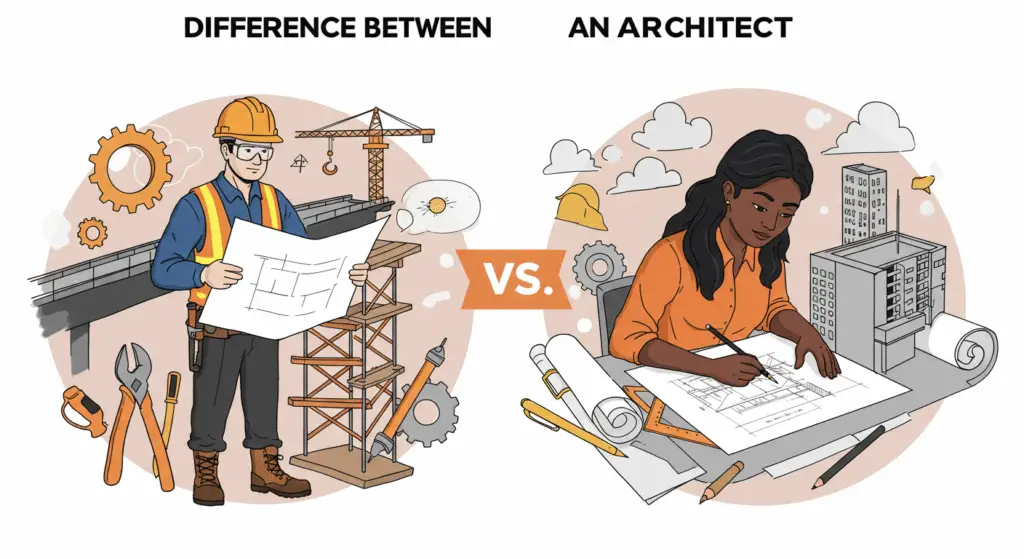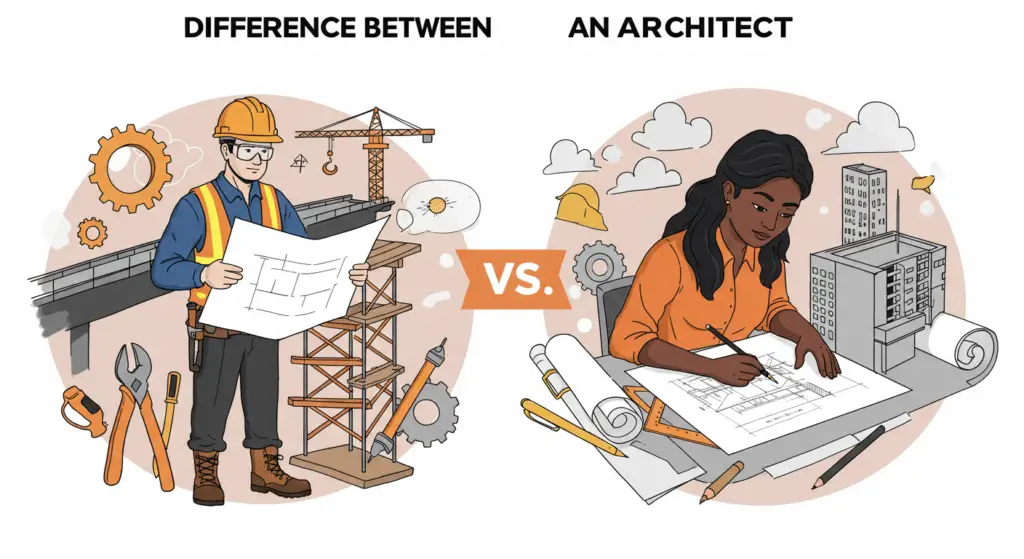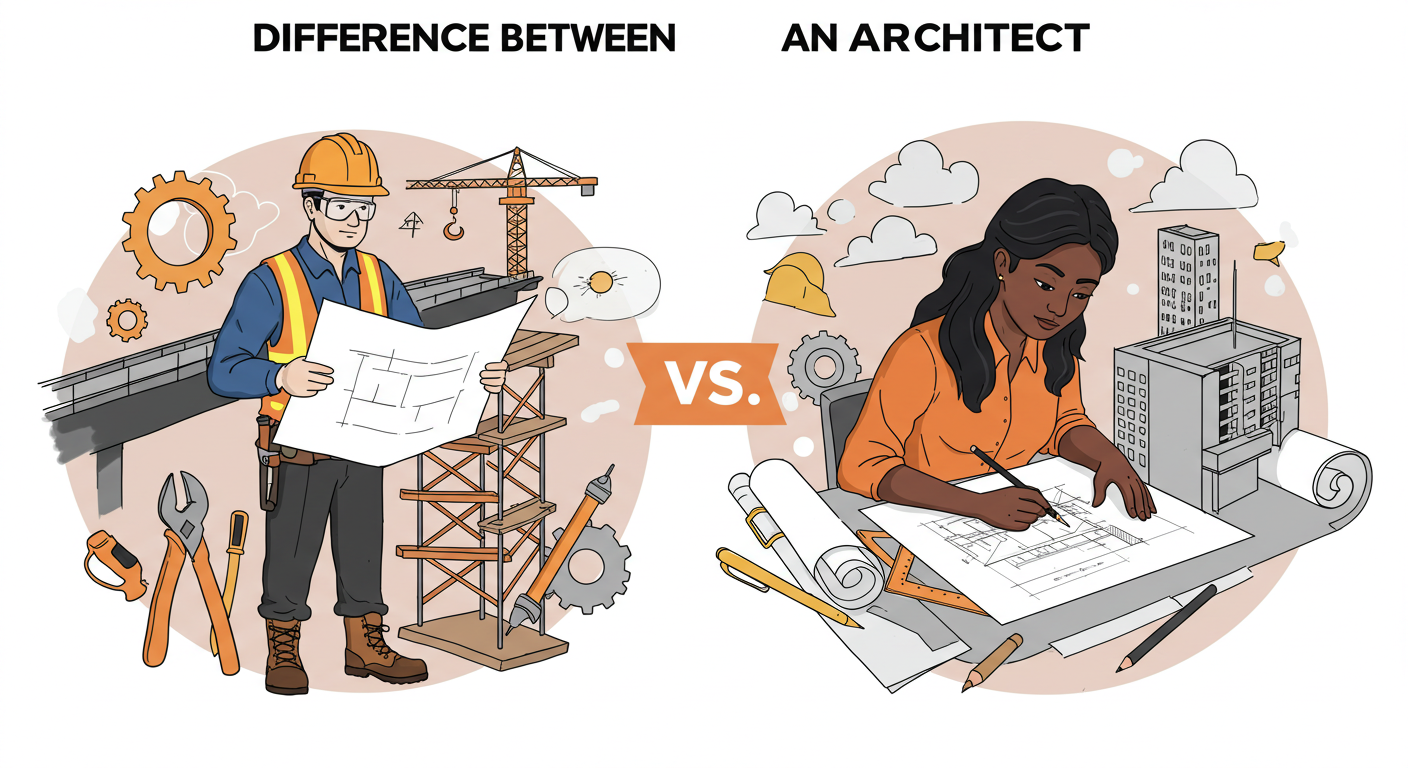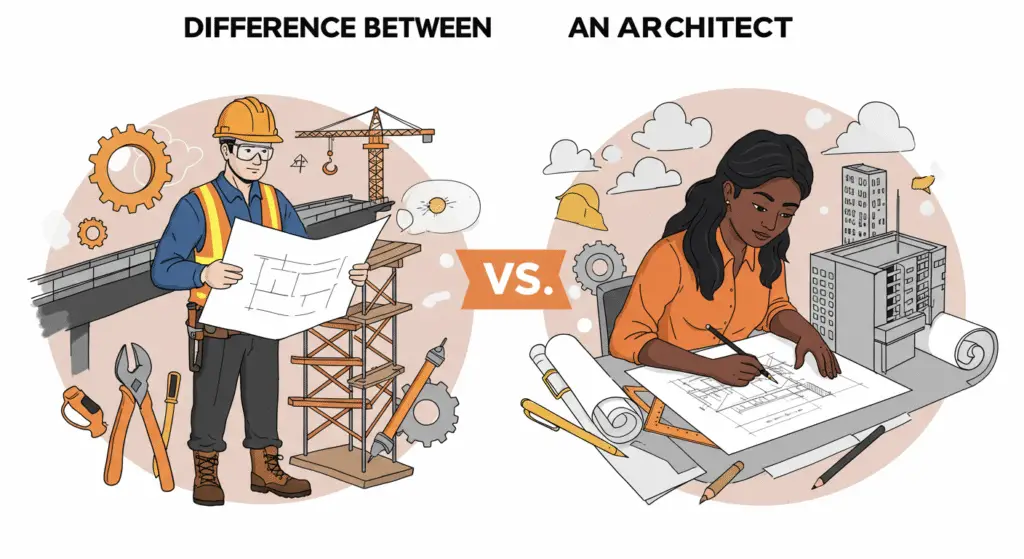The Difference Between an Engineer and an Architect

Difference Between an Engineer and an Architect
Table of Contents
- Introduction
- 1.1. Overview of Engineers and Architects
- 1.2. Importance of Understanding the Difference
- Education and Training
- 2.1. Educational Requirements for Engineers
- 2.2. Educational Requirements for Architects
- 2.3. Licensing and Certifications
- Roles and Responsibilities
- 3.1. Role of an Engineer
- 3.2. Role of an Architect
- 3.3. Collaboration Between Engineers and Architects
- Career Paths and Specializations
- 4.1. Career Paths for Engineers
- 4.2. Career Paths for Architects
- 4.3. Specializations Within Engineering and Architecture
- Work Environment and Lifestyle
- 5.1. Work Environment for Engineers
- 5.2. Work Environment for Architects
- 5.3. Lifestyle Differences
- Salary and Compensation
- 6.1. Salary Ranges for Engineers
- 6.2. Salary Ranges for Architects
- 6.3. Factors Influencing Compensation
- Creative vs. Technical Focus
- 7.1. The Creative Aspect of Architecture
- 7.2. The Technical Aspect of Engineering
- 7.3. Balancing Creativity and Technicality
- Challenges and Opportunities
- 8.1. Challenges Faced by Engineers
- 8.2. Challenges Faced by Architects
- 8.3. Opportunities in Both Professions
- Future Trends and Innovations
- 9.1. Emerging Trends in Engineering
- 9.2. Emerging Trends in Architecture
- 9.3. Impact of Technology on Both Professions
- Conclusion
- 10.1. Summary of Key Differences
- 10.2. Final Thoughts on Choosing a Career Path

Difference Between an Engineer and an Architect
1. Introduction
1.1. Overview of Engineers and Architects
Engineers and architects are two of the most respected and sought-after professions in the world. While both professions involve designing and creating structures, they have distinct roles, responsibilities, and requirements. Engineers are primarily concerned with the technical and practical aspects of building design, ensuring that structures are safe, functional, and meet specific requirements. Architects, on the other hand, focus on the aesthetic, functional, and environmental aspects of building design, often serving as the creative visionaries behind a project.
1.2. Importance of Understanding the Difference
Understanding the difference between engineers and architects is crucial for anyone considering a career in these fields, as well as for clients and stakeholders who need to know who to hire for their specific needs. While there is some overlap in the skills and knowledge required for both professions, the roles are distinct and require different educational backgrounds, skill sets, and approaches to problem-solving.
2. Education and Training

2.1. Educational Requirements for Engineers
Engineers typically require a bachelor’s degree in engineering or a related field. The specific type of engineering (e.g., civil, mechanical, electrical, etc.) will determine the course of study. Engineering programs are heavily focused on mathematics, physics, and other sciences, as well as practical applications and problem-solving. Many engineers also pursue advanced degrees, particularly if they wish to move into leadership or research roles.
2.2. Educational Requirements for Architects
Architects, on the other hand, typically require a professional degree in architecture, such as a Bachelor of Architecture (B.Arch) or a Master of Architecture (M.Arch). These programs are designed to provide a comprehensive education in both the artistic and technical aspects of building design. Architecture programs often include coursework in design, history, theory, and building systems, as well as hands-on studio work.
2.3. Licensing and Certifications
In many countries, architects are required to be licensed in order to practice. This typically involves completing a professional degree, gaining a certain amount of work experience, and passing a licensing exam. Engineers may also require licensure, particularly if they are working in roles that impact public safety, such as structural engineering. Certifications and professional memberships can also be important for advancing one’s career in both fields.
3. Roles and Responsibilities

3.1. Role of an Engineer
Engineers are responsible for the technical aspects of building design and construction. They ensure that structures are safe, functional, and meet specific requirements. This may involve designing and testing materials, systems, and structures, as well as solving problems that arise during the construction process. Engineers often work on a wide range of projects, from bridges and highways to buildings and machinery.
3.2. Role of an Architect
Architects are responsible for the overall design of buildings and other structures. They work closely with clients to understand their needs and preferences, and they use their creativity and technical knowledge to create designs that are both functional and aesthetically pleasing. Architects also play a key role in ensuring that buildings are sustainable, energy-efficient, and meet local building codes and regulations.
3.3. Collaboration Between Engineers and Architects
Engineers and architects often work together on large-scale projects, with engineers focusing on the technical aspects and architects focusing on the design. Effective collaboration is essential to ensure that the final product meets both functional and aesthetic requirements. Architects may provide the initial design concept, while engineers ensure that the design is feasible and can be constructed safely and efficiently.
4. Career Paths and Specializations

4.1. Career Paths for Engineers
Engineers can pursue a wide range of career paths, depending on their area of specialization. Civil engineers may work on infrastructure projects such as roads, bridges, and airports. Mechanical engineers may work on the design and development of mechanical systems, such as engines and heating and cooling systems. Electrical engineers may work on electrical systems, including power generation and distribution. With experience, engineers can move into leadership roles, such as project manager or engineering director.
4.2. Career Paths for Architects
Architects can also pursue a variety of career paths. Many architects start their careers as junior architects, working under the supervision of more experienced architects. With time and experience, they may move into senior roles, such as project architect or principal architect. Some architects may choose to start their own firms, while others may move into related fields such as urban planning or interior design.
4.3. Specializations Within Engineering and Architecture
Both engineers and architects can choose to specialize in specific areas of their field. Engineers may specialize in a particular type of engineering, such as aerospace engineering or biomedical engineering. Architects may specialize in a particular type of architecture, such as residential, commercial, or sustainable architecture. Specializing can help professionals stand out in their field and increase their earning potential.
5. Work Environment and Lifestyle

5.1. Work Environment for Engineers
Engineers typically work in office settings, where they spend much of their time designing, analyzing, and problem-solving. They may also spend time on construction sites, overseeing the implementation of their designs. Depending on their specialization, engineers may work in a variety of settings, from laboratories to factories. The work environment for engineers is often fast-paced and requires strong attention to detail and analytical skills.
5.2. Work Environment for Architects
Architects also typically work in office settings, where they spend much of their time designing and meeting with clients. However, they may also spend time on construction sites, overseeing the progress of their projects. Architects often work in creative environments, where they can express their artistic vision. The work environment for architects is often collaborative, requiring strong communication and interpersonal skills.
5.3. Lifestyle Differences
The lifestyle of engineers and architects can differ in several ways. Engineers may have more predictable hours, particularly if they are working in an office setting. Architects, on the other hand, may have more variable hours, particularly when they are working on deadlines or overseeing construction projects. Both professions require a strong commitment to lifelong learning, as they must stay up-to-date with the latest technologies and trends in their field.
6. Salary and Compensation

6.1. Salary Ranges for Engineers
The salary for engineers can vary widely depending on their area of specialization, level of experience, and location. On average, engineers tend to earn higher salaries than architects, particularly in specialized fields such as petroleum engineering or aerospace engineering. Entry-level engineers may earn around $60,000 to $80,000 per year, while experienced engineers can earn $100,000 or more.
6.2. Salary Ranges for Architects
The salary for architects can also vary depending on their level of experience, location, and type of firm. On average, architects tend to earn slightly less than engineers, particularly in the early stages of their careers. Entry-level architects may earn around $40,000 to $60,000 per year, while experienced architects can earn $80,000 to $100,000 or more.
6.3. Factors Influencing Compensation
Several factors can influence the compensation for both engineers and architects, including the size and type of firm, the location of the job, and the level of experience. Engineers and architects who work in large cities or in high-demand fields may earn higher salaries than those who work in smaller towns or in less specialized areas. Additionally, those who choose to pursue advanced degrees or certifications may have greater earning potential.
7. Creative vs. Technical Focus

7.1. The Creative Aspect of Architecture
Architecture is often seen as a more creative profession, as it involves designing buildings and spaces that are both functional and aesthetically pleasing. Architects must have a strong sense of spatial reasoning and an eye for detail, as well as the ability to bring their creative vision to life. While architecture does require a strong technical understanding, the creative aspect is often more prominent in the early stages of the design process.
7.2. The Technical Aspect of Engineering
Engineering, on the other hand, is often seen as a more technical profession, as it involves solving practical problems and ensuring that structures are safe and functional. Engineers must have a strong understanding of mathematics, physics, and other sciences, as well as the ability to analyze data and make informed decisions. While creativity can play a role in engineering, particularly in the design process, the technical aspect is often more prominent.
7.3. Balancing Creativity and Technicality
Both engineers and architects must find a balance between creativity and technicality in their work. While architects may focus more on the creative aspects of design, they must also ensure that their designs are technically feasible and meet safety and regulatory requirements. Similarly, engineers must use their technical expertise to bring the architect’s vision to life, while also considering the practical and functional aspects of the design.
8. Challenges and Opportunities

8.1. Challenges Faced by Engineers
Engineers face a variety of challenges in their work, including tight deadlines, budget constraints, and the need to stay up-to-date with the latest technologies and regulations. Additionally, engineers may face challenges in communicating their technical expertise to non-technical stakeholders, such as clients or project managers. However, these challenges also present opportunities for engineers to develop their problem-solving and communication skills.
8.2. Challenges Faced by Architects
Architects also face a variety of challenges, including the need to balance creative vision with practical constraints, managing client expectations, and ensuring that projects are completed on time and within budget. Additionally, architects must stay up-to-date with the latest trends and technologies in building design and construction. However, these challenges also present opportunities for architects to develop their creative and problem-solving skills.
8.3. Opportunities in Both Professions
Both engineers and architects have a wide range of opportunities for career advancement and professional growth. With the increasing focus on sustainability and environmental responsibility, there are growing opportunities for engineers and architects to work on green building projects and develop innovative solutions to environmental challenges. Additionally, the globalization of the construction and engineering industries has created opportunities for professionals to work on international projects and collaborate with colleagues from around the world.
9. Future Trends and Innovations

9.1. Emerging Trends in Engineering
The field of engineering is constantly evolving, with new technologies and innovations emerging all the time. Some of the most significant trends in engineering include the increasing use of artificial intelligence and machine learning, the development of sustainable and renewable energy sources, and the growing importance of cybersecurity in engineering systems. These trends are creating new opportunities for engineers to develop innovative solutions to complex problems.
9.2. Emerging Trends in Architecture
The field of architecture is also undergoing significant changes, with a growing focus on sustainability, energy efficiency, and smart building technologies. Some of the most significant trends in architecture include the increasing use of building information modeling (BIM), the development of modular and prefabricated buildings, and the growing importance of resilience and adaptability in building design. These trends are creating new opportunities for architects to create innovative and sustainable designs.
9.3. Impact of Technology on Both Professions
Technology is having a profound impact on both engineering and architecture, changing the way professionals in these fields work and the types of projects they undertake. Advances in computer-aided design (CAD) software, 3D printing, and virtual reality are enabling engineers and architects to create more complex and detailed designs than ever before. Additionally, the increasing use of data analytics and simulation tools is allowing professionals to make more informed decisions and optimize their designs for performance and efficiency.
10. Conclusion

10.1. Summary of Key Differences
In summary, while both engineers and architects play important roles in the design and construction of buildings and other structures, there are significant differences between the two professions. Engineers are primarily focused on the technical and practical aspects of building design, ensuring that structures are safe, functional, and meet specific requirements. Architects, on the other hand, are focused on the aesthetic, functional, and environmental aspects of building design, often serving as the creative visionaries behind a project. Both professions require a strong educational foundation, as well as ongoing professional development and a commitment to staying up-to-date with the latest trends and technologies.
10.2. Final Thoughts on Choosing a Career Path
For individuals considering a career in either engineering or architecture, it’s important to carefully consider their interests, skills, and career goals. Engineers who enjoy problem-solving and have a strong aptitude for mathematics and science may find a rewarding career in engineering. Architects who are passionate about design and have a creative vision may find a fulfilling career in architecture. Ultimately, both professions offer a wide range of opportunities for creative expression, technical challenge, and professional growth, making them excellent choices for individuals who are passionate about building and creating.